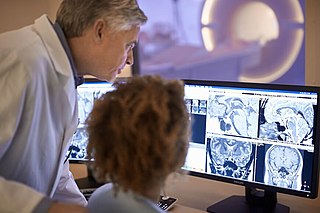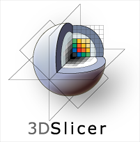Related Research Articles

Magnetic resonance imaging (MRI) is a medical imaging technique used in radiology to form pictures of the anatomy and the physiological processes of the body. MRI scanners use strong magnetic fields, magnetic field gradients, and radio waves to generate images of the organs in the body. MRI does not involve X-rays or the use of ionizing radiation, which distinguishes it from CT and PET scans. MRI is a medical application of nuclear magnetic resonance (NMR) which can also be used for imaging in other NMR applications, such as NMR spectroscopy.

Prostate cancer is cancer of the prostate. The prostate is a gland in the male reproductive system that surrounds the urethra just below the bladder. Most prostate cancers are slow growing. Cancerous cells may spread to other areas of the body, particularly the bones and lymph nodes. It may initially cause no symptoms. In later stages, symptoms include pain or difficulty urinating, blood in the urine, or pain in the pelvis or back. Benign prostatic hyperplasia may produce similar symptoms. Other late symptoms include fatigue, due to low levels of red blood cells.

Radiology is the medical discipline that uses medical imaging to diagnose and treat diseases within the bodies of animals and humans.

Medical imaging is the technique and process of imaging the interior of a body for clinical analysis and medical intervention, as well as visual representation of the function of some organs or tissues (physiology). Medical imaging seeks to reveal internal structures hidden by the skin and bones, as well as to diagnose and treat disease. Medical imaging also establishes a database of normal anatomy and physiology to make it possible to identify abnormalities. Although imaging of removed organs and tissues can be performed for medical reasons, such procedures are usually considered part of pathology instead of medical imaging.

Elastography is any of a class of medical imaging modalities that map the elastic properties and stiffness of soft tissue. The main idea is that whether the tissue is hard or soft will give diagnostic information about the presence or status of disease. For example, cancerous tumours will often be harder than the surrounding tissue, and diseased livers are stiffer than healthy ones.
Image-guided surgery (IGS) is any surgical procedure where the surgeon uses tracked surgical instruments in conjunction with preoperative or intraoperative images in order to directly or indirectly guide the procedure. Image guided surgery systems use cameras, ultrasonic, electromagnetic or a combination or fields to capture and relay the patient's anatomy and the surgeon's precise movements in relation to the patient, to computer monitors in the operating room or to augmented reality headsets. This is generally performed in real-time though there may be delays of seconds or minutes depending on the modality and application.

Prostate biopsy is a procedure in which small hollow needle-core samples are removed from a man's prostate gland to be examined for the presence of prostate cancer. It is typically performed when the result from a PSA blood test is high. It may also be considered advisable after a digital rectal exam (DRE) finds possible abnormality. PSA screening is controversial as PSA may become elevated due to non-cancerous conditions such as benign prostatic hyperplasia (BPH), by infection, or by manipulation of the prostate during surgery or catheterization. Additionally many prostate cancers detected by screening develop so slowly that they would not cause problems during a man's lifetime, making the complications due to treatment unnecessary.

High-intensity focused ultrasound (HIFU) is a non-invasive therapeutic technique that uses non-ionizing ultrasonic waves to heat or ablate tissue. HIFU can be used to increase the flow of blood or lymph, or to destroy tissue, such as tumors, via thermal and mechanical mechanisms. Given the prevalence and relatively low cost of ultrasound, HIFU has been subject to much research and development. The premise of HIFU is that it is a non-invasive low cost therapy that can at minimum outperform the current standard of care.

Brain biopsy is the removal of a small piece of brain tissue for the diagnosis of abnormalities of the brain. It is used to diagnose tumors, infection, inflammation, and other brain disorders. By examining the tissue sample under a microscope, the biopsy sample provides information about the appropriate diagnosis and treatment.

Interventional magnetic resonance imaging, also Interventional MRI or IMRI, is the use of magnetic resonance imaging (MRI) to do interventional radiology procedures.
NeuroArm is an engineering research surgical robot specifically designed for neurosurgery. It is the first image-guided, MR-compatible surgical robot that has the capability to perform both microsurgery and stereotaxy.
Computer-assisted surgery (CAS) represents a surgical concept and set of methods, that use computer technology for surgical planning, and for guiding or performing surgical interventions. CAS is also known as computer-aided surgery, computer-assisted intervention, image-guided surgery, digital surgery and surgical navigation, but these are terms that are more or less synonymous with CAS. CAS has been a leading factor in the development of robotic surgery.

3D Slicer (Slicer) is a free and open source software package for image analysis and scientific visualization. Slicer is used in a variety of medical applications, including autism, multiple sclerosis, systemic lupus erythematosus, prostate cancer, lung cancer, breast cancer, schizophrenia, orthopedic biomechanics, COPD, cardiovascular disease and neurosurgery.
Urology Robotics, or URobotics, is a new interdisciplinary field for the application of robots in urology and for the development of such systems and novel technologies in this clinical discipline. Urology is among the medical fields with the highest rate of technology advances, which for several years has included the use medical robots.

Automated tissue image analysis is a process by which computer-controlled automatic test equipment is used to evaluate tissue samples, using computations to derive quantitative measurements from an image to avoid subjective errors.

Positron emission tomography–magnetic resonance imaging (PET–MRI) is a hybrid imaging technology that incorporates magnetic resonance imaging (MRI) soft tissue morphological imaging and positron emission tomography (PET) functional imaging.
Vertebral osteomyelitis is a type of osteomyelitis that affects the vertebrae. It is a rare bone infection concentrated in the vertebral column. Cases of vertebral osteomyelitis are so rare that they constitute only 2%-4% of all bone infections. The infection can be classified as acute or chronic depending on the severity of the onset of the case, where acute patients often experience better outcomes than those living with the chronic symptoms that are characteristic of the disease. Although vertebral osteomyelitis is found in patients across a wide range of ages, the infection is commonly reported in young children and older adults. Vertebral osteomyelitis often attacks two vertebrae and the corresponding intervertebral disk, causing narrowing of the disc space between the vertebrae. The prognosis for the disease is dependent on where the infection is concentrated in the spine, the time between initial onset and treatment, and what approach is used to treat the disease.

Ferenc Andras Jolesz was a Hungarian-American physician and scientist best known for his research on image guided therapy, the process by which information derived from diagnostic imaging is used to improve the localization and targeting of diseased tissue to monitor and control treatment during surgical and interventional procedures. He pioneered the field of Magnetic Resonance Imaging-guided interventions and introduced of a variety of new medical procedures based on novel combinations of imaging and therapy delivery.
PI-RADS is an acronym for Prostate Imaging Reporting and Data System, defining standards of high quality clinical service for multi-parametric Magnetic Resonance Imaging (mpMRI), including image creation and reporting.
A central nervous system tumor is an abnormal growth of cells from the tissues of the brain or spinal cord. CNS tumor is a generic term encompassing over 120 distinct tumor types. Common symptoms of CNS tumors include vomiting, headache, changes in vision, nausea, and seizures. A CNS tumor can be detected and classified via neurological examination, medical imaging, such as x-ray imaging, magnetic resonance imaging (MRI) or computed tomography (CT), or after analysis of a biopsy.
References
- 1 2 Gassert, Roger; Roland Moser; Etienne Burdet; Hannes Bleuler (April 2006). "MRI/fMRI-Compatible Robotic System With Force Feedback for Interaction With Human Motion". IEEE/ASME Transactions on Mechatronics. 11 (2): 216–224. doi:10.1109/TMECH.2006.871897.
- 1 2 3 4 5 Yang B, Tan UX, McMillan A, Gullapalli R, Desai JP (December 2011). "Design and Control of a 1-DOF MRI Compatible Pneumatically Actuated Robot with Long Transmission Lines". IEEE/ASME Transactions on Mechatronics. 16 (6): 1040–1048. doi:10.1109/TMECH.2010.2071393. PMC 3205926 . PMID 22058649.
- 1 2 3 4 5 Krieger A, Iordachita II, Guion P, Singh AK, Kaushal A, Ménard C, Pinto PA, Camphausen K, Fichtinger G, Whitcomb LL (November 2011). "An MRI-compatible robotic system with hybrid tracking for MRI-guided prostate intervention". IEEE Transactions on Biomedical Engineering. 58 (11): 3049–60. doi:10.1109/TBME.2011.2134096. PMC 3299494 . PMID 22009867.
- 1 2 Su, Hao; Zervas, Michael; Cole, Gregory A.; Furlong, Cosme; Fischer, Gregory S. (2011). "Real-time MRI-guided needle placement robot with integrated fiber optic force sensing". 2011 IEEE International Conference on Robotics and Automation. pp. 1583–1588. doi:10.1109/ICRA.2011.5979539. ISBN 978-1-61284-386-5.
- 1 2 Ho M, McMillan A, Simard JM, Gullapalli R, Desai JP (October 2011). "Towards a Meso-Scale SMA-Actuated MRI-Compatible Neurosurgical Robot". IEEE Transactions on Robotics. 2011 (99): 213–222. doi:10.1109/TRO.2011.2165371. PMC 3260790 . PMID 22267960.
- ↑ Tsekos NV (2009). "MRI-guided robotics at the U of houston: Evolving Methodologies for interventions and surgeries". 2009 Annual International Conference of the IEEE Engineering in Medicine and Biology Society. 2009. pp. 5637–5640. doi:10.1109/IEMBS.2009.5333681. PMID 19964404.
- ↑ Sergi F, Krebs HI, Groissier B, Rykman A, Guglielmelli E, Volpe BT, Schaechter JD (2011). "Predicting efficacy of robot-aided rehabilitation in chronic stroke patients using an MRI-compatible robotic device". 2011 Annual International Conference of the IEEE Engineering in Medicine and Biology Society. 2011. pp. 7470–7473. doi:10.1109/IEMBS.2011.6091843. ISBN 978-1-4577-1589-1. PMC 5583722 . PMID 22256066.